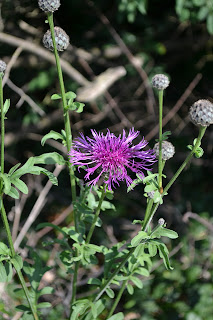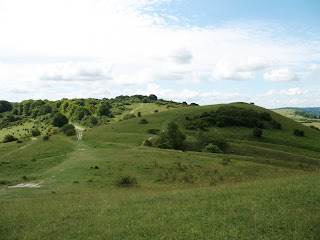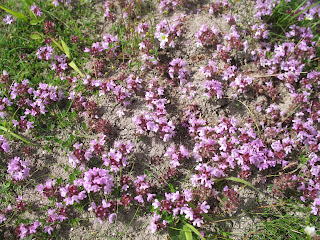30 June 2011 OS Explorer 181 & 192
Length: All day
This walk mainly concerns two quite different botanical interests – the chalk flora of the Ivinghoe Beacon escarpment (National Trust) and the “Aylesbury prune”, a domestic plum surviving in hedgerows and orchard remnants in the Edlesborough-Totternhoe region either side of the border between Bucks and Bedfordshire. A bonus is a trip round Whipsnade and some exotic animals!
We parked at the car-park for Ivinghoe Beacon by a minor road (Beacon Road) between the B489 and the B4506 (SP964160). At the car-park there was musk thistle Carduus nutans, an attractive thistle which bows its head to show off the large red-purple flowers. We took the main path northwards towards Ivinghoe Beacon, paralleling the road. Already, before 10am, butterflies were active, most notably marbled white and ringlet. One of the latter was feeding on a beautiful clump of large thyme Thymus pulegioides beside the path. Also along here was greater knapweed Centaurea scabiosa.
Greater knapweed
When we reached the point where the Icknield Way and other paths meet south of the Beacon, we entered open downland with a magnificent display of pyramidal orchid Anacamptis pryamidalis, fragrant orchid Gymnadenia conopsea, spiny rest-harrow Ononis spinosa, kidney vetch Anthyllis vulneraria, large thyme, fairy flax Linum catharticum, squinancywort Asperula cynanchica, burnet-saxifrage Pimpinella saxifraga, rock-rose Helianthemum nummularium, dwarf thistle Cirsium acaule, bee orchid Ophrys apifera, common spotted orchid Dactylorhiza fuchsii , common eyebright Euphrasia nemorosa, chalk eyebright E. pseudokerneri, hoary plantain Plantago media, carline thistle Carlina vulgaris, salad burnet Sanguisorba minor var minor, agrimony Agrimonia eupatoria, glaucous sedge Carex flacca, upright brome Bromopsis erecta, crested hair-grass Koeleria macrantha and quaking-grass Briza media. Cowslips Primula veris, of course, were now in seed.
Spiny rest-harrow
Fragrant orchid
Bee orchid
Rock-rose
Small heath butterflies and burnet moths were active here.
Narrow-bordered 5-spot burnet on spotted orchid
Following the Icknield Way to the Beacon, on the left-hand side is a number of deep ancient ditches.
Path coming from car park, Icknield Way & ancient ditches
View from near the ancient ditches
On the tops here can be found early gentian Gentianella anglica, but there was no sign at this date – early June would be the time to find them.
Early gentian (taken late May)
Here there were shells of the heath snail Helicella itala which, despite its name, is characteristic of chalk downs. It is prettily marked with spirals of black and white, while underneath is a very wide “umbilicus”. There were also a few fritillary butterflies flying rapidly to and fro, as is their wont. It took some time to get close enough to them to recognise from the white-spotted greenish underwing that these were dark green fritillary.
Dark green fritillary
Past here, in longer grass, were wild mignonette Reseda lutea, yellow rattle Rhinanthus minor, clustered bellflower Campanula glomerata and dropwort Filipendula vulgaris.
Wild mignonette
Dropwort
Approaching the summit, site of an iron age hillfort, there were people with model gliders making use of the strong up-draughts from the precipitous slopes of this narrow ridge, while many more people gathered around the Beacon itself, resting from the climb and enjoying the wide views over the plain to the north and west.
View towards Edlesborough
View towards Ivinghoe Aston
View of White Lion on Dunstable Downs below Whipsnade
Here we came across a rare cuckoo bee Bombus (Psithyrus) rupestris, a look-alike of the common red-tailed bumble bee on which it preys.
Approaching the summit of Beacon Hill
We left the main trails and followed informal paths winding down the north slope of the Beacon to hawthorn scrub at the bottom, with a whitethroat singing. On the open chalk grassland down here there were lots of both species of thyme Thymus pulegioides and T. polytrichus, mouse-ear hawkweed Pilosella officinarum, basil Clinopodium vulgare, clustered bellflower and horseshoe vetch Hippocrepis comosa.
Wild thyme
Horseshoe vetch
Wild basil
Bearing west we reached Beacon Road just above where it joins the B489. Just across the B489, to the right, we took the Two Ridges Link going NW down through sheep pasture next to a barley field. (The Two Ridges Link trail connects the Ridgeway at Ivinghoe Beacon to the Greensand Ridge Walk at Leighton Buzzard, an 8-mile walk.) To the east was a view of lynchets (possibly survivals of Anglo-Saxon ploughland) on the hillside and above sang skylarks. By a gate on the left this path turns at right-angles to the right across the field towards another hedge-line, passing below the lynchets.
When we reached the road the footpath went through a kissing-gate on the left and along the crop-field inside the hedge for the length of the field before exiting into the lane. This gave us a chance to see the arable annuals. Although these were quite abundant they were virtually all very common species: field pansy Viola arvensis, black bindweed Fallopia convolvulus, sun spurge Euphorbia helioscopa, scarlet pimpernel Anagallis arvensis ssp arvensis, common field speedwell Veronica persicifolia, common fumitory Fumaria officinalis ssp officinalis, common poppy Papaver rhoeas, field bindweed Convolvulus arvensis, cut-leaved crane’s-bill Geranium dissectum and red dead-nettle Lamium purpureum. The only less common exceptions were a number of plants of both dense-flowered and few-flowered fumitory, Fumaria densiflora & F. vaillantii.
Common poppies
We went left along the lane into Ivinghoe Aston. On the left was a hedgerow of wild plums, still green, almost certainly “Aylesbury prune” (Prunus domestica cultivar) which was widely planted in orchards in this region, including Edlesborough, Eaton Bray and Totternhoe, as well as closer to Aylesbury. The prune (old local word for plum) suckers easily and naturally spreads from orchards into hedgerows, where it is now established. The youngest shoots are red-brown and downy, the older ones developing a grey bloom, while the trunks develop vertical fissures. Galls on many of the leaves were made by the mite Eriophyes similis and there were also mines caused by larvae of the micro-moth Parornix finitimella.
Aylesbury Prune
A common hoverfly Syrphus vitripennis on plum leaves
Swifts flew over the houses, where jackdaws, house sparrows and collared doves were all common. Out the other side of the village the hedge on left of the road again contained specimens of Aylesbury prune. Common broomrape Orobanche minor was flowering on the roadside.
Common broomrape
Keeping to the Two Ridges Link trail, we turned right up a track to Vine Farm, past some obviously sown cornfield annuals and nectar-plants, including long-headed poppy Papaver dubium, and alongside a pond with coot. The path crosses a grassy area in front of the house, with a few old Aylesbury prunes showing that this used to be an orchard.
Old Aylesbury Prune at Vine Farm
At the corner a bridge took us over a stream and along a path NW of the farm, past a younger apple orchard to the left, and many more Aylesbury prunes in the hedge, along with many hop-vines, another plant that was once grown in hedges around orchards for the brewing industry. The hedgerow ends and the path continues across a field of wheat. This took us to Butler
The lane emerges into the A4146 at The Swan, where we turned right and then immediately left along the lane to Eaton Bray, with one of the casualties of main roads – a dead hedgehog – at the corner. This lane crosses the border from Bucks into Bedfordshire at a stream, as recognised by a carved stone on the bridge. At the next road junction is a small village green with the White Horse at the side, a convenient stop for a lunch-break, busy already at 12.30pm.
White Horse
After a good rest we took the right of way opposite the pub along a minor lane called The Comp going east, passing much more hop. (“Comp” is a strange name, perhaps from the Anglo-Saxon cumb meaning “valley”, or a later Norman introduction from the Latin campus or “field”. The Anglo-Saxon camp means “battle”, but we can find no reference to such an event at Eaton Bray.) We carried straight across another track along a footpath, past a series of trees of domestic apple and pear marking an old hedge-line, a linear orchard. We turned right at the first junction, between a hedge and a potato-field, the hedge containing much spindle Euonymus europaeus, dogwood Cornus sanguinea, and both black and white bryony, Tamus communis & Bryonia dioica. This becomes a double hedge bordering the path and then, over a stile, our way was bordered by a hedge on one side and a wheat-field on the other. The village of Totternhoe was visible across the fields to the north, straggling along a ridge, while ahead we could clearly see the much higher ridge of Dunstable Downs, with both gliders and hang-gliders active.
We crossed another path and a broken-down stile before our path bent left through a wheat-field. Crossing two streams we eventually entered cow-pasture, with a glimpse of a remnant orchard over the northern hedge boundary. We turned left at the end of this field along a path to Totternhoe, crossing another stream. We found we could walk along the barley-field edge to the left here and get to the side of the orchard we had just glimpsed. It was entirely old Aylesbury prunes, with one younger tree by the fence.
Old Aylesbury Prune orchard
Having got a good view here, we retraced our steps to the original path and continued eastwards along it towards Church End through horse-pasture. There was another remnant Aylesbury prune orchard on the north side of this field, easily visible this time, with house martins swooping after insects around the old trees.
Second Aylesbury Prune orchard
The path became a track with more Aylesbury prune in the hedge and another orchard remnant behind the hedge on the right. Instead of continuing to the road we turned right along a path at the edge of the village, emerging at the road by the church. Across the road was another footpath diagonally across a cow-pasture, a wheat-field, a stream and another wheat-field. Up a bank at the end we emerged at the bend in a lane where we turned left for a short way to Doolittle Mill. Here a bridleway to the left took us to Well Head, turning right along a track to the B489, across which it continued up the slope of Dunstable Downs, past the London Gliding Club on the right.
Looking down on Gliding Club (path at bottom right)
As we climbed the soil became more calcareous and we passed clumps of sainfoin Onobrychis viciifolia before we reached a gate into open downland.
Sainfoin
Here the Chiltern Way passed across us, but we decided to head for the top of the ridge by continuing straight ahead along a path which became very steep. At the top was a rich turf of wild thyme, rock-rose, dropwort, thyme-leaved sandwort Arenaria serpyllifolia and salad-burnet Sanguisorba minor ssp minor. We now turned right along the Icknield Way, a major path going SW near a recognised roadside “viewpoint”, busy with quite a few families even on a weekday. There were indeed splendid views west over the plain (including the approaching storm-clouds!).
View from Dunstable Downs
The view helped a little to compensate for the lack of botanical interest in what was essentially pasture intensively grazed by sheep and rabbits.
Young rabbits
The path continued through a section of National Trust land with woods on the slope below. Just before the B4540 we turned right by a car-park along what was signed as the Whipsnade Circular Route (also Icknield Way and Ridgeway Path!). No paths continue south along the ridge because of the presence of Whipsnade Wildlife Animal Park
The first part of this new track enters an old sunken way and runs down to Dell Farm and the B4540 just before Whipsnade village. We turned left as far as a wide bend where a paved track leads straight on (Studham Lane), becoming an unpaved way after a few houses and going through what was effectively a green tunnel with hedgerow trees meeting overhead. A right turn is well-signed along a very tall fence marking the edge of the zoo, behind which is tall grass meadowland for deer. We could see several fawns and does eyeing us carefully, large ears standing up to catch the least sound – Indian blackbuck and hog deer. Beyond these were some strange, almost deer-like, large rodents – Patagonian cavies, back legs longer than front ones and a prominent white stripe along the rump. Further on again were larger deer, perhaps Pére David’s, and resting bison. We passed an occasional large oak.
Eventually the trail leaves the perimeter fence of Whipsnade and goes left across a golf-course and right past the club-house, here re-entering Bucks. The path leads down through trees to a different Studham Lane, where the Icknield Way turns right along the road a little way (past some greater celandine Chelidonium majus) and then leaves to the left at a bend. This leads to the A4146, where we turned right and walked along the road right through the rather dull village of Dagnall
Path up to Ivinghoe Hills
At the edge of crops wall barley Hordeum murinum was catching the late afternoon sun with a shimmer of silver, interrupted by the crimson spots of common poppies, while field bindweed hugged the ground with a carpet of pink and white. Sometimes it is the most common flowers that provide the most impressive sights.
Wall barley catching the sun
Common poppy
After one kilometre the track diverges left around Hog Hall and then continues inexorably uphill at the edge of a narrow wood and to Ward’s Hurst Farm, where small nettle Urtica urens was growing in the trampled mud and pied wagtails searched for insects. To the right a herd of deer grazed along with sheep, presumably being farmed for venison. At this farm the path turns right to head towards Ivinghoe Beacon, but rapidly loses height by descending through damp mixed woodland into The Coombe past patches of ramsons Allium ursinum.
Arion ater slugs at least enjoy the damp conditions
We ascended more gently out of the woodland on to a grassy slope, where there were some old beech Fagus sylvatica and yellowhammers singing from the scrub, eventually rejoining our original path from the car-park at the junction of many paths.
Old beech
Instead of taking the main path back to the car-park we did not cross the stile but kept on the eastern side of the fence, a minor path that also leads to a stile into the car-park. In the chalk grassland here we discovered a dozen or more plants of great pignut Bunium bulbocastanum, a plant now restricted to just a few sites along the Chiltern escarpment and the chalk ridge as far as Cambridge
Great pignut flowers
Great pignut in fruit



































A really enjoyable blog entry - I'll forward the link to chums with whom I came to the Chilterns for chalk-hill butterflies in pre-Covid days (!)
ReplyDelete